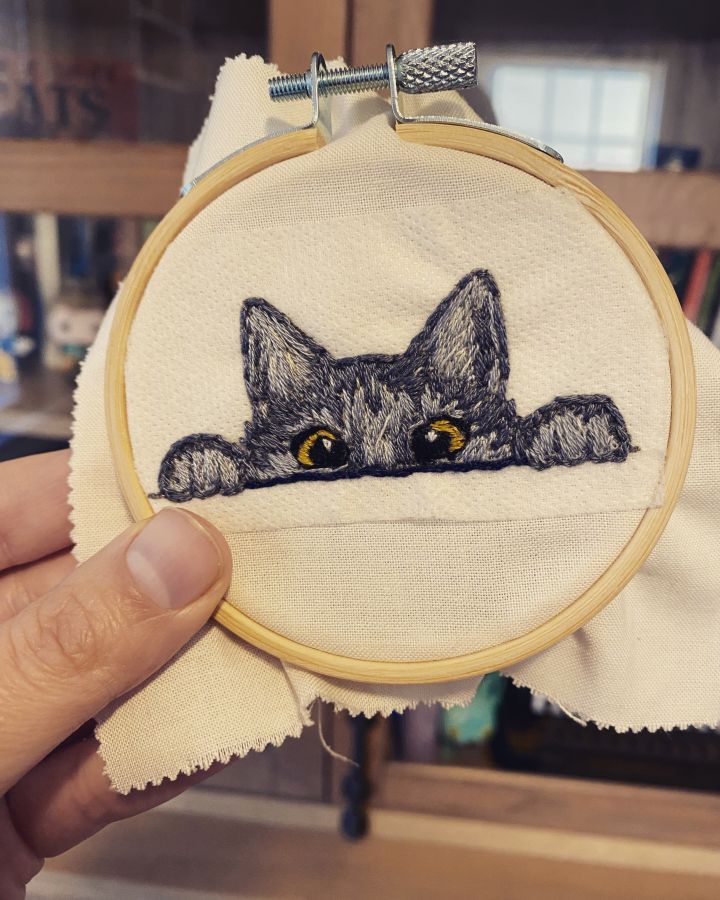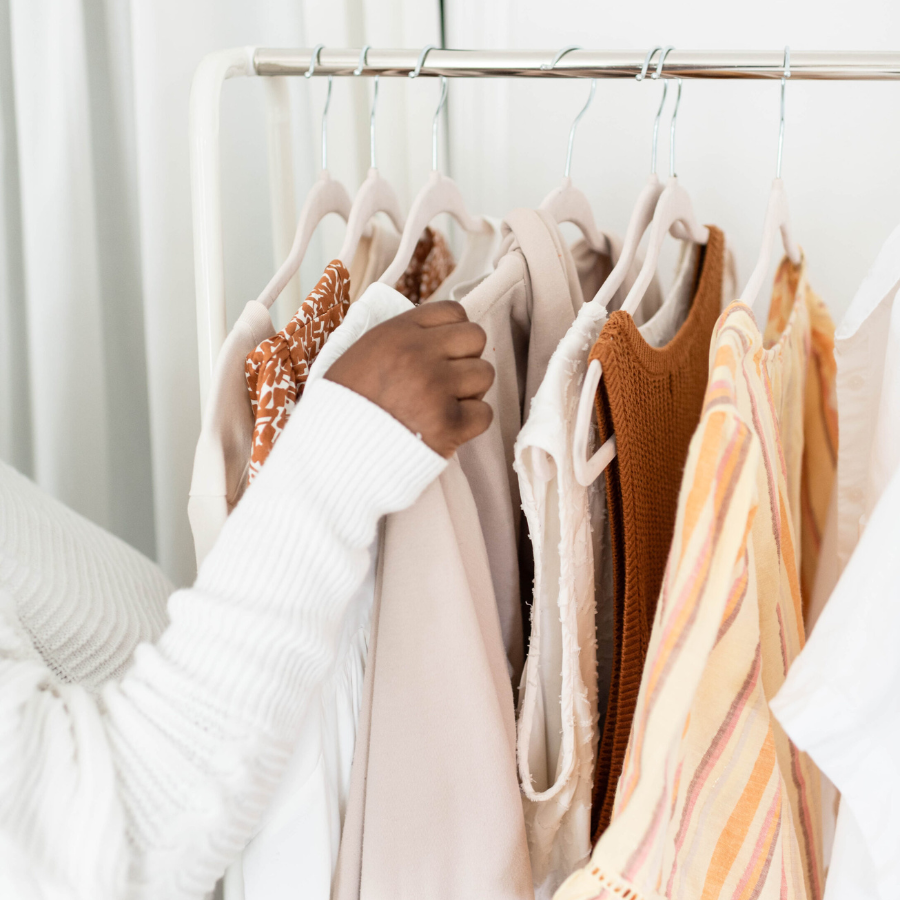This post may include affiliate links, which means we make a small commission on any sales. This commission helps Feminist Book Club pay our contributors, so thanks for supporting small, independent media!
Almost a year ago, all of us here at the Feminist Book Club read Aja Barber’s Consumed and I immediately realized I was part of the problem. There were the new batches of clothing I’d buy on the cheap from Old Navy whenever I realized last year’s clothes didn’t fit me. There were the cheap-ass leggings and jeggings I’d begun ordering off Amazon during the pandemic, wearing them until they came apart at the seams and then ordering replacements. There were the donations I made to Vietnam Veterans of America every season, not realizing most of it likely ended up in overseas landfills. I’d thought I was doing pretty well but, really, I was an environment-destroying monster! (OK, I’m not a monster, but I could be doing better.)
But fast fashion is so cheap, which—as someone with a pretty low income, and as someone whose weight is constantly fluctuating—I appreciate. It’s tough to invest in ethical, sustainable clothing (because better-made, sustainable clothing can be an investment) when you don’t know if you’ll fit into it over the long haul.
Also, many sustainable brands have a long way to go when it comes to inclusive sizing, a fact that became especially evident when I tried to find a single nice pair of jeans around which to build a capsule wardrobe.
For the love of god.
Before I say more, I should point out that I hover right at the line between straight-sized and plus-sized. In the realm of those who struggle to find cute clothing that fits their body, I do have it easier than many.
But I still find it hard to find clothing that fits well, that’s flattering, that doesn’t make me feel as if my internal organs are being squeezed to within an inch of their life, and that makes me feel like the goddamn goddess that I am.
I recently read Elizabeth L. Cline’s The Conscious Closet, and it inspired me to try some new things, which I’ll list below. Maybe something here will also give you an idea or two for dressing sustainably in a way that makes sense for you.
I Found New Ways to Recycle the Old Stuff
I’ve always prided myself on clearing out the house at least twice a year, boxing up stuff we no longer use, bagging up clothing that no longer fits, and scheduling pickups with good ol’ VVA. In the past, I assumed I was giving those items new life, making them available to others who could use them while also removing the emotional weight of all that clutter.
When I learned that much of that clothing doesn’t end up where I’d assumed, I was horrified. What were my other options?
I recently cleaned out my closet again, this time organizing items into different piles. I put aside some of my old socks, earmarking them for a second life as rags or, in the case of some of the knee-highs, as homemade heating pads. The rest of the socks are being mailed to Knickey’s textile recycling program, while old undies and bras are being mailed to Parade’s Second Life recycling program. Clothing and accessories that are higher-end, in fantastic shape, and maybe even a little bit trendy are being sent to the resale site ThredUp. And everything else? I’ve researched local thrift shops and nonprofits that are looking for donations so I can get a better sense of where my castoffs are going. (The great hope? Not a landfill.)
I Sought Out Ethical Brands
I understand that one of the tenets of sustainable fashion is buying less, not more. But when your entire wardrobe is built upon a foundation of cheap fabrics and ill-fitting clothing, it might be time to think about rebuilding.
After I cleared my closet of items that no longer fit or that I never wore, I took stock of what was left. What did I have more than enough of? (Leggings, jeggings, and decent-looking everyday tops.) What was I always scrambling to find at the last possible moment? (Dress pants, nice tops, and decent shoes that could travel anywhere from a conference to a funeral.) What did I skimp on and have to constantly replace like a total fool? (Shoes and, well, see earlier about cheap-ass jeggings; I could totes use one high-quality pair of jeans.)
Don’t get me wrong. I don’t plan to buy all of the items I’m lacking all at once. I could never afford it and my boots, for example, will likely last me several more seasons, especially if I continue using my local cobbler. But I’m attending a conference in April, so a good pair of pants and a nice blouse would be nice to have.
Enter: Ethical Clothing Brands.
What does it mean to be an ethical clothing brand? According to Good on You, an online database—and also an app—that rates different brands, sustainability is built upon everything from greenhouse gas emissions and water use to worker safety and living wages.
I lean on Good on You’s app heavily when considering whether to purchase something new from a certain brand.
But as I mentioned earlier, many brands are not also size-inclusive, and I’ve for sure sought out posts like The Good Trade’s “17 Size-Inclusive and Affordable Sustainable Brands You Need to Know” and “15 Sustainable Plus Size Clothing Brands That Match Your Style” as a shortcut for finding brands that will work for me. It’s how I discovered and fell in love with Parade (I have never before been so excited about thermal underwear) and I can’t wait to get a pair of jeans from Loup. And though I probably have enough yoga apparel to last me through the apocalypse, if I ever need more items, I am so trying Girlfriend Collective. I’m also a former StitchFix lover, so I’m excited to try Seams Better, an ethical clothing subscription box. Because, honestly? I am hopeless when it comes to dressing myself.
I Considered Shopping the Resale Sites
Because even if a piece of clothing doesn’t come from an ethical brand, giving it a second life can keep it out of the landfill.
Also, you can sometimes find secondhand items from those higher-end brands on the cheap on sites like ThredUp, Poshmark, and The RealReal, some of which are actively seeking out more size-inclusive donations.
Also, do y’all remember when we Zoomed with Cat Polivoda, the founder of CAKE, a plus-size retail shop? Those exist out in the wild and, heck, even if there isn’t one near you, there’s still a chance you can find some good stuff in your size at your local, generic thrift shops, even if you have to dig a little deeper.
I Started Mending My Clothing
I know. Who even am I? But learning embroidery has emboldened me. And reading books like Katrina Rodabaugh’s Mending Matters helped.
Just the other week, I hemmed a pair of palazzo-style pajama pants I was always tripping over. And when my jeggings started getting holes in the corners of their back pockets, where I hook my thumbs to pull them up, I legit patched them up, even going so far as to embroider this cute-as-hell butt patch:

During The Great Closet Clean-Out, I put aside a small pile of other clothing that also needs mending. The goal is to take care of those projects about once a month so items don’t just languish in the closet or get tossed.
I have to say, I think the commitment to mending will help with legging/jegging turnover especially, as the inner thighs on my pants tend to get worn out pretty quickly because of, well, having thighs that touch each other. (Heaven forfend!)
I’m Starting to Phase Out All Single-Use Items
This last item is relevant to folks of all sizes, but I’m including it anyway, mostly because I consider my beauty and hygiene products to be part of my overall fashion routine.
I’ve been trying out LastObject’s LastRound and also their detergent sheets in order to eliminate the use of single-use cotton makeup rounds and large jugs of laundry detergent. I also use a menstrual cup and have ordered a couple of pairs of period underpants in order to eliminate my use of pantyliners and maxi pads. Canceling my standing Subscribe & Save pantyliner order at Amazon was immensely gratifying. (I literally said, “muahahaha” out loud as I was doing it.)
Aaaand that’s what I’ve been up to. Mind you, this is all fairly new to me, and I’d love to hear any tips you have or see links to any resources you use.
Speaking of which…
If you want to hear from other FBC contributors on sustainable fashion, Jacquelyn wrote this great post on why we should be concerned about fast fashion, Natalia and Lucy talked gender, fashion, and feminism, and Niba chatted with Emma Wasserman about whether sustainable fashion is even possible.
I also recommend checking out Lauren Bravo’s How to Break Up with Fast Fashion, Sonya Philip’s The Act of Sewing, and Jacqueline Cieslak’s Embody.
And for some Instagram inspo, there’s Alex of Shiny by Nature, a colorful, size-inclusive fashion brand; Marielle Elizabeth, who shares fat-positive content and information on plus-size, ethical fashion brands; Lydia Morrow, who creates underwear for all sizes and genders; and Lydia Okello, whose colorful outfits make me smile, and who speaks often about the need for inclusivity in sustainable fashion.
Go forth and be glorious, my peeps.


